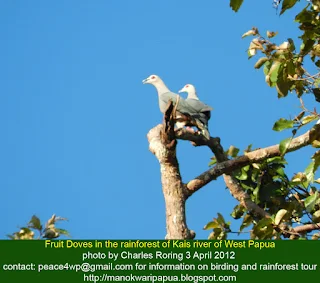There are some birding cameras from old models that are still good for anyone to buy in affordable prices. The one that I used was Fujifilm HS50EXR. It has got 42× zoom lenses that were equal to 1,000 mm lenses in 35 mm format. Because its image sensor was 1/2 inches, it could focus on birds faster than the average point and shoot cameras whose CMOS image sensors were 1/2.3 inches.
I also used to have Nikon Coolpix P500 and Nikon Coolpix P600. Both were good for taking pictures in distant trees where the light condition is good. The cameras cannot easily focus on birds in lowlight condition.
 |
| Pinon Imperial Pigeon shot by using Nikon Coolpix P500 |
On the internet, there are articles from birdwatchers about Canon SX50. They said that the SX 50HS produced bird pictures that are better that its successor the SX60HS. This opinion could be true. Sor, if there are online stores that sell Fujifilm HS50EXR or Canon SX50HS in very good condition. They are buying.
Bridge birding camera cannot be compared with D-SLR camera. The size of image sensor in bridge camera is much smaller than the full frame.
| I used to take picture of bird using a binocular and a pocket camera. The result was not sharp and bright but was good enough for identification. |
Today, universal adapter has allowed people with cell phone spotting scope or binocular to take pictures of birds. So, anyone who cannot buy a birding camera can still enjoy birding photography with his or her cellphone that is embedded to spotting scope or binoculars using universal camera adapter.
I like to stand on a slope near a tree where a bird sits on to get near eye-level position. Sometimes, I stand on hill looking down at trees and take pictures of birds.
To enhance the quality or sharpness of the photograph that I take, I usually lean on a tree while holding the camera. Sometimes I use tripod. To eliminate shakes or vibration when I press the shutter button, I apply a 3-second self-timer. The camera will take picture 3 seconds later after I press the shutter button. This was written by Charles Roring
Also read: Birding Cameras

